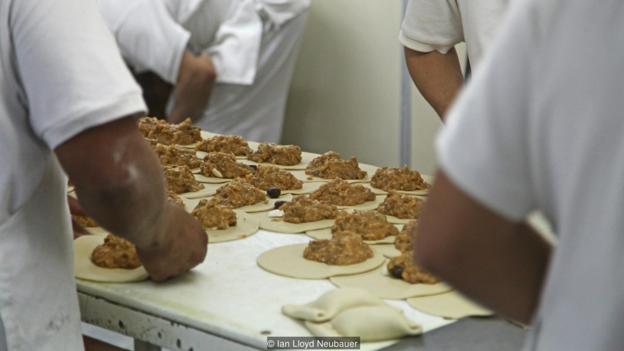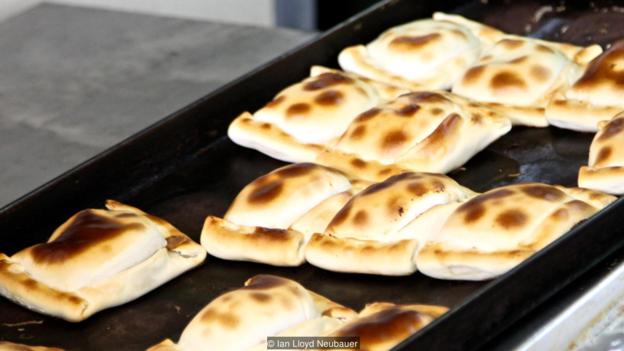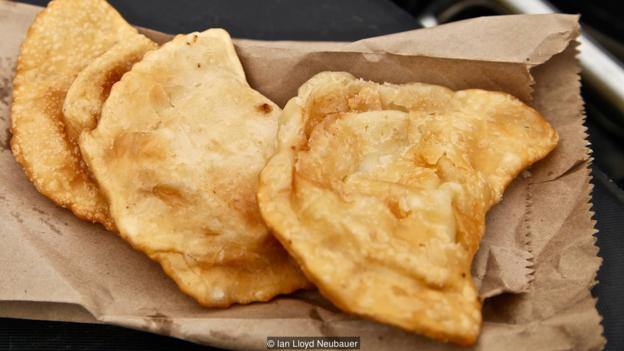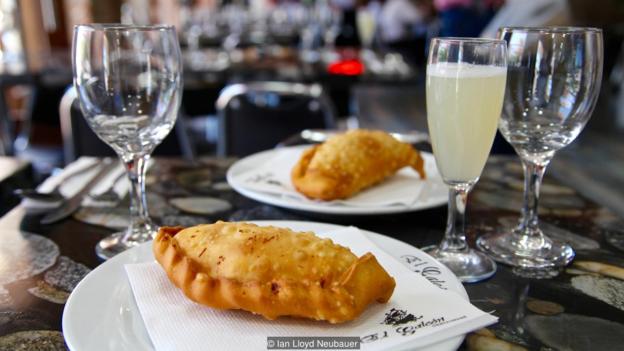A pastry filled with meat, cheese or seafood might sound simple, but Chile’s national dish takes time, cooperation and a lot of love to get right.
When Marxist politician Salvador Allende became president of Chile in 1970, he called for a “revolution flavoured with red wine and empanadas†– the latter being Chile’s national dish, pastry filled with meat, cheese or seafood.
But the celebrations didn’t last long. Under a policy of collectivisation, Allende’s Minister of Agriculture Jacques Chonchol, who happens to be my second uncle, seized thousands of farms and handed them over to the proletariat – who promptly ran them into the ground. The ensuing economic crisis saw basic commodities disappear from supermarket shelves and hundreds of thousands flee Chile in search of greener pastures.
My parents were among them, migrating to Melbourne. And while they may have left their homeland, they never gave up their traditions, nor their foods. Growing up in Australia, empanadas were our equivalent of a Sunday roast – a meal that took time, cooperation and a lot of love to prepare.

The process would begin on Saturday nights when my mother would simmer a pot of minced meat flavoured with olives, eggs and raisins. The following morning, the kids would gather in the kitchen and help her cut pastry into portions, fill them with the mince and roll them into parcels. Baked in the oven until golden brown, empanadas were normally served with a garden salad. Ketchup was allowed, but discouraged – and unnecessary. My mother’s empanadas had such depth of flavour that the mere thought of them makes my mouth water.
Last month, I travelled to Chile to report on the making of a new national park in the country’s deep south. While transiting through the capital Santiago, I also undertook a secondary assignment: a gastronomical quest to find an empanada as good as or, god forbid, even better than my mum’s.
First bite
My first port of call was Tomas Moro, a bakery in the suburb of Las Condes that won third place in an annual blind-tasting test of more than 50 popular empanada venues by the Circle of Gastronomical Writers of Chile. Tomas Moro’s empanadas are so popular that locals line up for hours on weekends to buy them by the dozens.

To avoid the queues, I went on a weekday and bought an empanada de pino filled with meat, olives and onion. Rectangular shaped with a golden sheen, it certainly looked the part – but once I bit in, it left me wondering what all the fuss was about. There was very little meat inside, mostly just onion bits and gravy. Combined with a thick pastry, it left my crude Aussie palette screaming for ketchup. It was like eating an onion-flavoured dough ball.
My second attempt to find a good empanada also fell short. At El Rapido (The Fast One), an 87-year-old empanaderia in the heart of the city that my father once patronised between lectures at nearby Pontifical Catholic University, the pastries were served to customers within seconds of being ordered. My empanada was deep fried with a filling not too dissimilar to the second-grade “mystery meat†that factory-made pies are filled with in Australia. It tasted very ordinary, like junk food. El Rapido’s cheese empanada was somewhat better. Flat, round and about the size of a saucer, the pocket in the centre was filled with warm gooey cheddar.
The empanada legend
To help me in my quest, I enlisted the help of an expert – Manuel Garcia, a guide at Upscape who conducts food tours in Santiago.
I met Garcia at the Plaza de Armas, the original centre of the city where Inés de Suárez, a mistress of Spanish conquistador Pedro de Valdivia, led a successful resistance with just 55 soldiers against a large host of indigenous raiders in the year 1540. She did so by ordering the decapitation of seven indigenous prisoners and tossing their heads over the walls – a barbaric act that made the raiders disperse in terror. According to Garcia, Suarez may also have created Chile’s first empanada.
“There are various theories on how the empanada was invented. But my favourite is a claim after the attack. When most of the Spaniard’s food supplies had been stolen or destroyed, Suárez found one remaining barrel of wheat,†Garcia said. “Instead of making bread, which would’ve been eaten relatively quickly, she made pastry. She then slaughtered the last remaining animals – a few horses and dogs – and used the meat to make the filling. Over the centuries, people started adding things like onions, olives, raisins and spices to improve the flavour. And in the past 30 or 40 years, people also started filling them with cheese, vegetables and seafood.â€
The key to a good empanada, Garcia told me, is eating them fresh out of the oven. “At many of the popular empanaderias, they freeze and reheat them. But the really good places cook them daily and hourly according to demand,” he said.

Garcia’s picada
Zunino Emporium, the first empanaderia Garcia took me to, is a short stroll from the Plaza de Armas on the periphery of Santiago’s Central Market. Founded in 1930 by Italian migrant Sebastian Zunino, it stakes a claim as Chile’s oldest empanaderia. It’s also one of the busiest, pumping out 3,000 empanadas a day.
“The secret to a good empanada,†said third-generation proprietor Claudio Zunino, “is cooking the filling the night before to give the flavour time to ripen and develop.â€
My mother would agree. “Empanadas always taste better the day after they’re cooked,†she used to say.
Zunino’s empanadas were significantly better than El Rapido’s and a step up from Tomas Moro’s. The light and airy pastry was generously filled. But the meat, once again, wasn’t top notch, as evidenced by the fact that empanadas here cost 30% less than they did almost everywhere else.
Our next stop was El Galeon, a sophisticated seafood restaurant set inside the market, whose specialty is fried empanadas filled with king crab from Chile’s Drake Passage.
“Alaskan king crabs may be better known, but Chilean king crabs are better,†said restaurateur Roman Basques. “The meat is softer and the flavour is more subtle.â€
Filled with cheese and a small helping of crabmeat, El Galeon’s empanadas offered a novel alternative to traditional meat pies, and went down swimmingly with a pisco sour, Chile’s national cocktail.
From the city, we drove to another market in the inner-city suburb of Providencia. It’s home to Tinita, a small empanadaria open since 1968 that sells around 300 pies daily. Garcia rates it as his favourite picada – a Chilean word for an eatery that is simple, cheap and serves great food.
“Our empanadas are not too posh and not of bad quality either,†said proprietor Jose Beti-Cotal. “We’re just in the middle of being a good empanada.â€

With big chunks of beef, thick rich gravy and soft, thin pastry, Tinita’s were the best empanadas I’d tried so far, despite Beti-Cotal’s modest review.
The winner
In travel, as in life, the best things are often discovered by chance. And so it was in my search for an unputdownable empanada, which I found not in Santiago but 2,000km south of the capital in Puerto Guadal, a village on the shores of Lake General Carrera, as I travelled to the national park.
When I arrived shortly before nightfall, I spotted an empanada sign outside a shop called Panaderia La Ruta. There were only three empanadas left, still warm from the oven, and I bought them all.
As I sunk my teeth into the first one, I knew I’d found a winner. The pastry was soft in the centre but crunchy on the edges. The filling was full-bodied and bursting with flavour, while the meat had a chunky texture that immeasurably enriched the dish.
The baker’s name was Marta Marquez and she told me her empanada recipe was passed down to her by her mother.

“The pastry,†Marquez explained, “is made of flour, eggs, milk, baking powder and a special brand of margarine for baking called Hornito. You have to mix it all evenly and then roll it into thin sheets, because thick dough is really just bread.â€
“For the filling,†she continued, “I add onions, half a hard-boiled egg for each empanada, pitted black olives, cumin seeds and smoked chilli flakes.
“But the secret,†she revealed, “is the way I prepare the meat. I don’t use mince. I buy topside beef and cut it into tiny cubes. It prevents the meat from drying out when cooked and creates a rich, juicy gravy.â€
Were they better than my mum’s empanadas? Yes and no. Yes, in that I couldn’t remember tasting a better empanada; and, no for the fact that my mum’s came with an intangible element of love, and all the nostalgia and longing that brings.
By Ian Lloyd Neubauer







